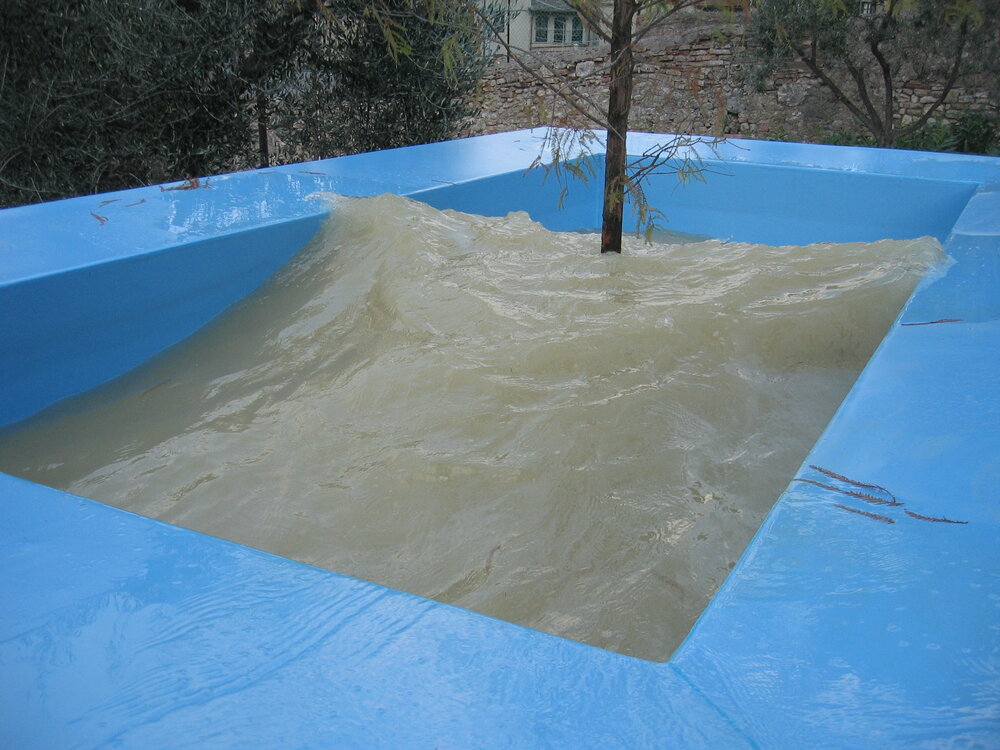“My friend Rachel Inman, one of the most beautiful names I know and wife of Riccardo, the designer of my exhibited work, after seeing the pool with the tree says to me: ‘So sad.’ I then ask: ‘Sad and bad or sad and good?’ ‘Sad and good.’”
I have always wondered how an object can convey emotions—how one can say that something is sad or joyful—despite the fact that there are books and treatises on this topic, many of which I have read during moments of particular discouragement. For me, a work is vision and “a vision of what exists.” Vision and “applied-feeling” are absolutely non-specialist fields; that is, they apply to all possible objects and actions, especially those dedicated to the world (by world I mean nature + humans), rather than just the world of humans. This thought always pushes me to create something that doesn't have a single interpretation but many—at least as many as a fork on a table might have. The attempt to place a work in the landscape involves more than a few risks: it gives up the privilege of aspiring to the immutable, of being above accident and chance. This presumption—of trying to become part of the landscape—can lead from perpetual change (beautiful today, not tomorrow) to the unequivocal disappearance of the work itself. In practice, reliability is sacrificed for the precision of that one day when landscape and inserted work strike a chord of indescribable beauty—like nature. Still, the advantages of this kind of practice are not few. The greatest, I believe, is that even you, the creator of the work, end up seeing it as an outsider. This leads to wonder at the thoughts others have when reflecting on the finished work. Rachel spoke of good sadness. Francesca said that the tree belonged to a ship whose navigation, I add, happens while standing still—and that it carries the waves within itself. With Remo, at the bar, we talked about Meister Eckhart—a phrase dear to me, which I found in his sermons and often dedicated to Grace: “Become by grace what God is by nature.” Once, in front of the work, Remo felt that this phrase perfectly described the attitude of the pool with the tree: making nature from man. This type of wave manifests a certain mathematics in its regular cyclicality; it is in fact describable through an equation, because the system (pool-tree) is constructed so that what are variables in the sea (water level, buoyancy) remain (or should remain) constant—in part thanks to the pool itself, which determines a small, more controllable ecosystem. To Remo, it also resembled a cradle; to some, the wave with the tree caused anxiety, to others it hypnotized, and to others still, it brought peace. To me, before making it, it evoked the comparison between static plant life and moving mineral matter, the vertical resistance to a horizontal motion; afterward, above all, it reminded me of the sound of the sea and a tree in a desert in the mountains.
Fino ad ora ho nominato 6 amici, ma certo coloro che hanno partecipato a questo lavoro sono molti di più: Mario, Maurizio, Massimo, Franco, Yari, Beppe, Piero, Vittorio, Sandra, e molti di più ancora se si considera che ho 42 anni.”
— Massimo Bartolini, Arte all’Arte VIII, 2004

